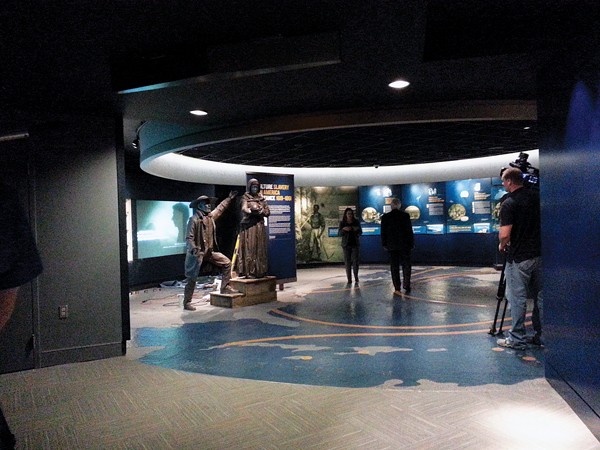The National Civil Rights Museum at the Lorraine Motel will present a commemoration in honor of Dr. Martin Luther King, Jr.’s life and legacy on Thursday, April 4, the 56th anniversary of his death. Martin Luther King III, wife Arndrea Waters King, and daughter Yolanda. Renee King will participate in the ceremony, which will be live streamed for those who cannot attend in person. This year, the Museum introduces a youth component with the performing winners of its Youth Poetry and Spoken Word Competition.
The event entitled “Remembering MLK: The Man. The Movement. The Moment.” will be held in the Museum’s courtyard at 4:00 pm Central with a musical prelude followed by the commemorative service at 4:30 pm. Participants can also join the live stream via the museum’s website, YouTube and Facebook platforms.
Martin Luther King III, the oldest son of the late Dr. Martin Luther King Jr. and Mrs. Coretta Scott King, will deliver the keynote address. Mr. King is a civil rights advocate and global humanitarian, focusing on addressing the most pressing social justice issues of today. Amplifying his father’s work, Mr. King has devoted his life to promoting global human rights and eradicating racism, violence, and poverty, earning a reputation as a respected international statesman and one of the world’s most passionate advocates for the poor and oppressed.
As chairman of the Drum Major Institute (DMI), a nonprofit rooted in his father’s work over 60 years ago, Mr. King collaborates closely with his wife, Arndrea Waters King and daughter, Yolanda Renee King, to advance Dr. King’s vision of a more just and equitable world. Founded in 1961, the organization focuses on continuing the King legacy through education, action, engagement with world leaders, and collaboration with socially conscious organizations.
Arndrea Waters King, social justice activist and President of Drum Major Institute (DMI), has championed several nonviolence, anti-hate and social change initiatives throughout her life, designing programs to advance understanding and activism. She is a strong supporter of youth activism and believes in helping young people take a peaceful, effective stand for the world issues that concern them most. As president of DMI, she plays a critical role in creating strategic partnerships and managing the daily operations of this active social justice organization.
At 15 years old, Yolanda Renee King, the only grandchild of Dr. King, is an activist and children’s book author having recently published We Dream A World, a tribute to her grandparent’s legacy. Having appeared on the world stage and in national media interviews, she uses her voice to speak up on key issues including gun violence, climate change, and racial equality.
As a teen creative, Yolanda King will lead the youth segment of the commemoration with words of inspiration and introduction of the “I AM the Legacy” poetry and spoken word winners to be announced this month. The competition is designed for high school students to use the performative art of poetry on topics that identify their thoughts, solutions, or designs on how they envision freedom, equality, and justice for their future. The competition is made possible by The Memphis (TN) Chapter of The Links, Incorporated.
“This year, the commemoration is poignant as we elevate the ‘drum major instinct’ Dr. King expressed, but with the fierce urgency of now,” said Dr. Russ Wigginton, Museum President. “Given today’s climate, we recognize we all must move toward greater justice, peace, and righteousness from wherever we stand,” he said.
Each year, the Museum commemorates the tragic event that occurred on the balcony of the Lorraine Motel in 1968. This year’s event features a keynote speaker, special performances, fraternal tribute, and changing the balcony wreath with a moment of silence at 6:01 pm Central when Dr. King was slain.
Rev. Dr. Dorothy Sanders Wells, the Rector of St. George’s Episcopal Church, will give remarks. Wells has recently been elected the first woman and first Black person elected as Bishop of the Episcopal Diocese of Mississippi.
W. Crimm Singers AKA Wakanda Chorale, a professional ensemble-in-residence of Tennessee State University’s Big Blue Opera Initiatives, will perform music of the Black experience throughout the diaspora and every genre connected to it with major emphasis on the Negro Spiritual, African American operatic, and concert repertoire, hymnody, and anthems.
During the 4:00 prelude, recorded speeches by Dr. King will broadcast in the museum courtyard. In the event of rain, the event will be held inside the museum’s Hooks Hyde Hall. For more information, visit April4th.org.

This article is sponsored by National Civil Rights Museum.

 Basheeradesigns | Dreamstime.com
Basheeradesigns | Dreamstime.com  Alexandra Pusateri
Alexandra Pusateri  Alexandra Pusateri
Alexandra Pusateri